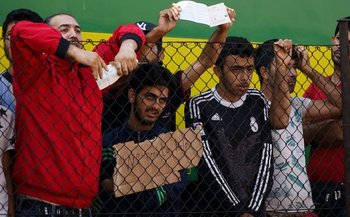In 1949, Simone de Beauvoir wrote that one is not born a woman (or man) but becomes a woman (or man) by upbringing and society’s differentiated space for men and women. Nearly 70 years later, when it comes to refugees, it is unfortunately still all too relevant.
Perceptions of the social roles of men and women play a decisive, if not reductionist role in the way non-Islamic politicians and media deal with refugees from the Syria crisis.
In short, women symbolise innocence and deserve our compassion. Men, on the other hand, depict danger. They are a danger to their own women, who they beat, oppress or rape. And they are a danger to society, as they are associated with violence, or even terrorism. When people depict refugees as a ‘terrorist threat’, without being explicit, they are invariably referring to the male refugee.
As Heather Crawley of Coventry University told me, male refugees are increasingly seen as a dangerous and criminal ‘other’. In reality, however, the vast majority of men have run away from violence and violent groups, and are also vulnerable victims seeking refuge.

Photo credit: Mstyslav Chernov-Trudeau
Having just completed research on refugee responses in Greece, Lebanon and Turkey, I have come to fear that humanitarian aid is similarly caught up in gender-stereotyping. There seems a complete blindness for what Maria Correia and Ian Bannon called ‘the other half of gender’, i.e. men.
While the concept of gender stands for the social roles of, and the relationships between, men and women, in the practice of humanitarian aid, gender almost always means women. Women are seen in the humanitarian sector as a vulnerable category of people. Even to the extent that we are presented with womenandchild, as if it’s one word, one amorphous category of vulnerable people. This is not necessarily positive for women either. Equating women with children, renders them as an object of care, not a social actor with agency to be taken seriously.
Psycho-social assistance often exclusively focuses on women as victims of violence. Men could be forcibly recruited, tortured, molested, shot or castrated, but their involvement in psycho-social support projects are rare. When these projects reach out to men, it is usually to engage them for the cause of women and make the advocates to stop violence against women. During my research I have seen numerous social projects for refugees, and I have not encountered a single exception: all projects are for women only.
Women are also seen as more reliable, and hence a better investment than men. There are fantastic and necessary projects that help women refugees advance economically. Many women are given the chance to start a small business. In cash transfers, women are also seen as the better recipient. One of the organisations I interviewed had a strongly gendered policy. “We provide women-headed households with direct cash transfers. When there is a man at the head of the family, we pay the rent directly, but we do not give cash. Men spend money on cigarettes and we have even had cases where men used the money to spend money on a new young bride to his household.” I have no reason to doubt this statement, but I am concerned in the lack of confidence in refugees has become too generalised and leads to denial of male suffering and vulnerability.
Let’s think about the dangers of this stereotyping for male refugees. A recent study has showed how especially young men may find themselves in a terribly difficult position. Men are expected to earn income. Yet in Lebanon, refugees are not allowed to work legally; in Turkey it has recently become possible to enter the labour market, but many employees prefer to hire refugees in informal jobs; and in Jordan there are no legal restrictions to work, yet there is very little employment. While many men manage to get involved in wage-earning, a substantial group of men sit idle at home: vulnerable and desperate.
It is only now, five years into the Syria Crisis, that organisations are starting to open up and recognise male gender-based vulnerabilities. The International Rescue Committee, who conducted the research, is one of the organisations reconsidering its gender policies, and carefully starts experimenting with socio-economic projects for men.
Male-female relations among refugees is a complex and unsettling topic, and studying the unintended effects of organisations’ attention to women leads, in the words of Maria Erikson Baaz and Maria Stern, to a ‘method of unease’. Many refugee women are abandoned or mistreated, and too many men play into the vulnerability of refugees to marry young girls. Abuse should be addressed. However, this should not lead to lumping all men together and massively cast them aside from the humanitarian gaze. There are countless male refugees who are vulnerable, reject violence, and are sincere in their intention to protect their loved ones. It is time to put the spotlight on our gender-biases.
The World Humanitarian Summit takes a core responsibility to bring about ‘safe, healthy and dignified lives for women and girls’. Let the WHS be where we also recognise the suffering of male refugees and bring about gender-based male problems to the surface.